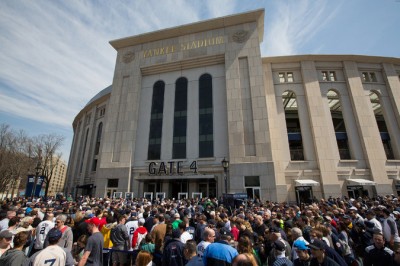U.S. Counter-terrorism? Baseball Park Metal Detectors Fail to Set Off Journalists’ BS Detectors

The New York Times depicts the crowd in front of Yankee Stadium–but doesn’t investigate whether the security measures that caused the crowd make anyone more secure. (NYT photo: Ruth Fremson)
The opening of the baseball season this week brought with it an unpleasant surprise for fans: Starting this year, Major League Baseball is requiring walkthrough metal detectors at all entrances, leading to long lines as opening day crowds queued up to be scanned. The New York Times (4/7/15) and Associated Press (4/6/15) both surveyed fans at multiple stadiums, mostly finding some exasperation (“It’s a hassle, but not that bad,” one 19-year-old Philadelphia Phillies fan told the Times) but overall acceptance of what the Times called a “robust new security policy borrowed from the counterterrorism arena.”
The reaction from fans — and readers — might have been different if any of the reporters had asked actual security experts about the efficacy of metal detectors at preventing terrorism. Because as I found in researching the topic for Vice Sports (9/23/14) last fall, there’s no evidence that walkthrough metal detectors at airports or ballgames make anybody safer — and reason to believe they may even make us less safe. As I reported, Alabama economist Walter Enders, who has co-authored several metal detector studies,
says that the main effect of tighter security at stadium entrances will likely be to drive any hypothetical attackers—and let’s remember that no actual terrorists have actually attacked sports venues in America outside of that time Bruce Dern tried it—to set off bombs outside stadiums instead, which would not be a happy outcome: “You’re trying to get in the door, there’s 20,000 people standing around outside. I could do a lot of damage there, just as easily as I could if I brought the thing inside. Maybe even more.” (His students, Enders notes, are constantly wondering aloud why no one ever simply flies an airplane over a stadium and drops an explosive device out the window.)
Besides, if we really cared about safety, Enders says, we’d do things like ensure that bag checks actually check bags, beyond a quick look to ensure that no one is smuggling in unauthorized foodstuffs. “I just went to see Alabama/West Virginia in Atlanta,” he notes. “My wife and I wanted to bring something in to drink. I said, ‘Put it in the bottom of the purse, and we’ll put the binoculars and the program on top, and that’s the end of that.’”
Harvard’s Bruce Schneier, meanwhile, who coined the term “security theater” for measures that look tough but accomplish little, said ballpark metal detectors were a perfect example of this phenomenon, noting that driving to the game is far more dangerous than anything you’ll face once you take your seats: “The police are eight or nine times more likely to kill you than a terrorist. This kind of crap is what the terrorists winning looks like.”
 Neither Schneier, Enders nor other independent experts were consulted in any of the opening day news coverage; the Times cited only John D. Cohen, who as the Department of Homeland Security’s counterterrorism chief until last summer helped put in place the policies that MLB drew on to develop its new program. In articles previewing the new detectors, the Arizona Republic (4/3/15) merely cited the Arizona Diamondbacks’ website claim that the new policy was meant to “make this ballpark and others around the country safe by utilizing enhanced security procedures,” while the St. Louis Post-Dispatch (4/2/15) consulted no one at all beyond noting that fans “accepted the enhanced security as a sensible, if depressing, development.” Asking questions about why the detectors are needed was left to a few bloggers;NBCSports.com‘s Craig Calcaterra (4/7/15) wrote that
Neither Schneier, Enders nor other independent experts were consulted in any of the opening day news coverage; the Times cited only John D. Cohen, who as the Department of Homeland Security’s counterterrorism chief until last summer helped put in place the policies that MLB drew on to develop its new program. In articles previewing the new detectors, the Arizona Republic (4/3/15) merely cited the Arizona Diamondbacks’ website claim that the new policy was meant to “make this ballpark and others around the country safe by utilizing enhanced security procedures,” while the St. Louis Post-Dispatch (4/2/15) consulted no one at all beyond noting that fans “accepted the enhanced security as a sensible, if depressing, development.” Asking questions about why the detectors are needed was left to a few bloggers;NBCSports.com‘s Craig Calcaterra (4/7/15) wrote that
I am aware of no security dangers inside ballparks — no widespread or systemic incidents of violence, terror or anything else — which made this new rule reasonable and necessary in the first place.
Some fans exhibited the skepticism that’s supposed to be the hallmark of journalism. “It’s a solution in search of a problem,” Phillies fan Jeff Young told the Associated Press. “If somebody wants to do something, they’ll figure out a way to do it. It just inconveniences roughly 2 million people a year for the sake of what? To me, it seems like a show.” It’s a reasonable question. Unfortunately, most daily news reporters haven’t bothered to try to answer it.

